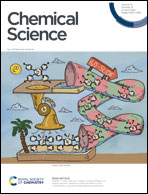Investigating the diastereoselective synthesis of a macrocycle under Curtin–Hammett control†
Abstract
This work sheds new light on the stereoselective synthesis of chiral macrocycles containing twisted aromatic units, valuable π-conjugated materials for recognition, sensing, and optoelectronics. For the first time, we use the Curtin–Hammett principle to investigate a chiral macrocyclisation reaction, revealing the potential for supramolecular π–π interactions to direct the outcome of a dynamic kinetic resolution, favouring the opposite macrocyclic product to that expected under reversible, thermodynamically controlled conditions. Specifically, a dynamic, racemic perylene diimide dye (1 : 1 P : M) is strapped with an enantiopure (S)-1,1′-bi-2-naphthol group (P-BINOL) to form two diastereomeric macrocyclic products, the homochiral macrocycle (PP) and the heterochiral species (PM). We find there is notable selectivity for the PM macrocycle (dr = 4 : 1), which is rationalised by kinetic templation from intramolecular aromatic non-covalent interactions between the P-BINOL π-donor and the M-PDI π-acceptor during the macrocyclisation reaction.

- This article is part of the themed collection: 2024 Chemical Science HOT Article Collection


 Please wait while we load your content...
Please wait while we load your content...